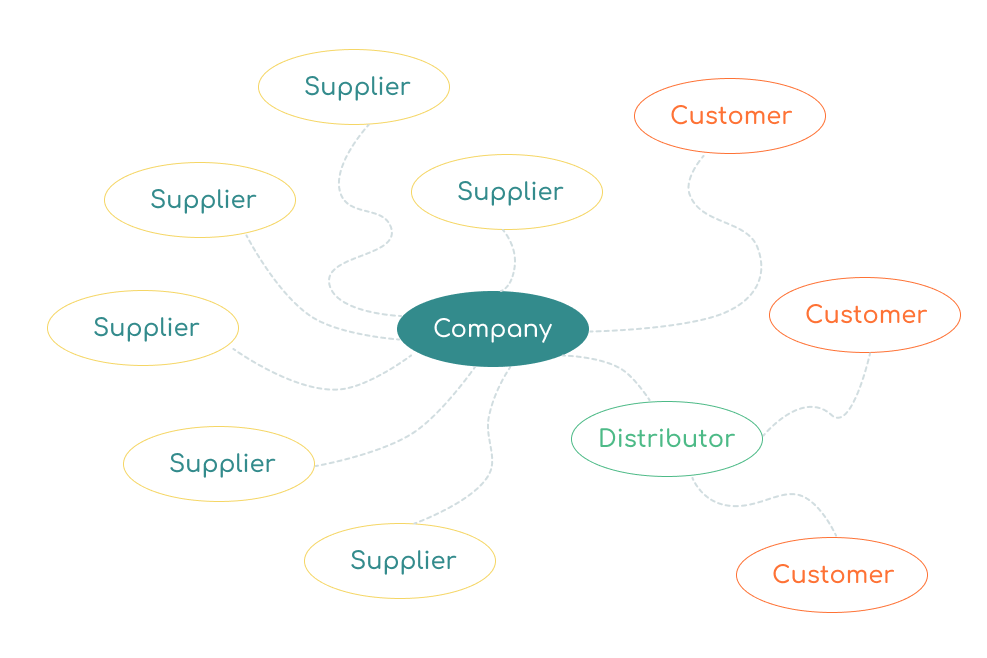Value Chain, Value Shop, and Value Network

There are different generic forms of value configuration, but in every concept, value comes first. It can be thought of as the financial equivalent that customers are willing to pay to get what is important to them but what they do not want or cannot do physically or legally.
Value Chain

The value chain allows seeing the creation of value at the company level. The company's activities divide into Primary activities and Support activities.
For example, consider an imaginary company that makes peach juice.

This company:
- Buys apples, sugar, bottles, and a bunch of other necessary resources for 1 million (Inbound Logistic);
- Produces juice (Operations) at its plant + 600 thousand;
- Delivers products to stores or dealers (Outbound Logistics) + 100 thousand;
- The sales department is engaged in promotion (Marketing) + 50 thousand.
- Service – everything related to aftermarket service support – if the company produced home appliances, this niche would be covered by warranty repairs;
- Administrative costs of the main office + 50 thousand;
- Recruitment, training, retention of staff + 50 thousand;
- Development and implementation of technical solutions + 50 thousand;
- Includes the purchase of everything the company needs to work: from raw materials to office supplies or buildings + 100 thousand for the modernization of equipment.
In total, the company invests 2 million (costs), and the revenue is 3 million. Where does 1 million come from?
That is the value.
It needs to be understood as interconnected areas to optimize performance and provide more value to customers. For example, introducing new software that tracks inventory balances and automatically generates orders for suppliers will allow you to optimize future purchases and reduce warehousing and logistics costs. Therefore by investing in one item, the firm can get savings in another.
The main goal of this model is to improve the level of profit the firm will receive.
Keep in mind that this is just a basic scheme that allows you to:
- deconstruct the structure of the firm,
- see how it works,
- find weaknesses and growth points,
- understand whether the company is allocating resources correctly.
In reality, no company looks like this, because an exceptionally small percentage of businesses have a closed production cycle.
Value Shop

At some point, it became clear that services are also products, and they began to occupy a growing niche in the market, but it is impossible to adapt the classic value chain scheme for them. That is how value shops appeared, which do not actually deliver goods on store shelves or at home but give access to the time and knowledge of experts to address the customers' unique needs.
Pricing here, too, is not a standard scheme: the price of the service is based on reputation, not value. The best example is the cost of legal services – firms in neighboring buildings can have radically different prices with approximately the same level of expertise. And the reason is not the cost of renting an office but the value of the name written on the plate.
The scheme works for the whole sphere of services, but medicine and consulting are two fields most often cited as examples. The logic of creating the value of stores is to change the state. Transforming a sick patient into a healthy person, or creating something that didn't exist: a building, a system, a new department, and so on. The company can earn by offering one service or complex solutions.
Consider the example of real estate services:
- A person is urgently looking for a new apartment because they do not like noisy neighbors and addresses the realtor (a person who has knowledge of the market and the current situation);
- The realtor selects several options according to the specified parameters;
- The person makes their choice (chooses one of the options or rejects all, and we return to the previous step);
- And rents the desired housing and moves – the problem is solved;
- After moving, a person evaluates new conditions and new neighbors and, if necessary, again addresses the realtor.
Value Network
Remember when we said that only a few companies work in a closed production cycle? When we mention any product, especially a technically complex one, we associate it with only one manufacturer and a specific brand, without thinking about what is really needed to make it and how many people are involved. That is why the question of creating value at a new level – the network level where we can see all the participants involved in the value formation process – the whole chain of suppliers.

It is not enough to set up everything within one company - the whole network must work effectively so that the customer gets what he wants and agrees to pay, and all network members - can make a profit.
The global shortage of microchips illustrates the interdependence of network participants.
When there are no microchips, there is a shortage of PlayStation 5. And all other console component suppliers, logistics companies, wholesalers, and retailers, directly Sony (for consoles and games sales) – are now short of potential profits.
That is how one of the network participants operating can dramatically change the profitability of the entire network.
Wish to optimize costs and automate routine processes?
Our team will help you succeed quickly and without extra expenses.